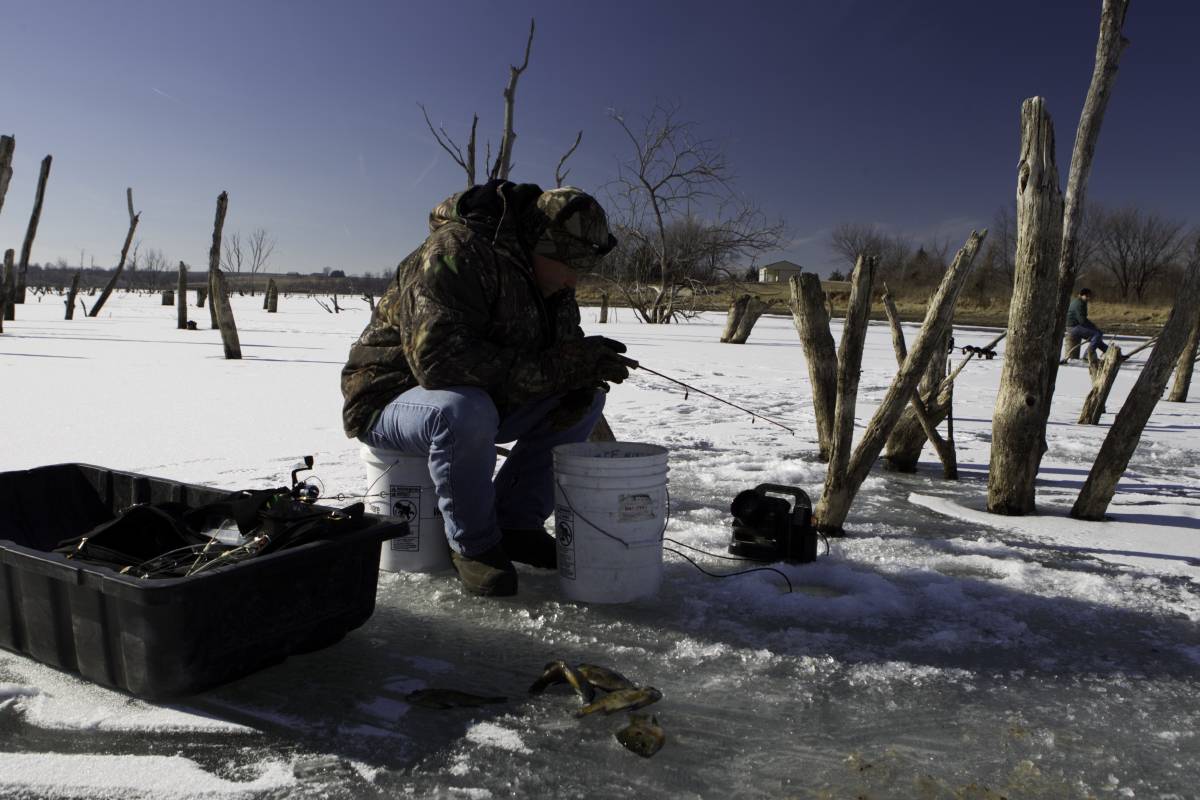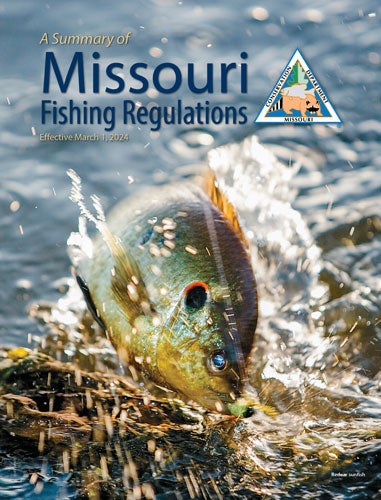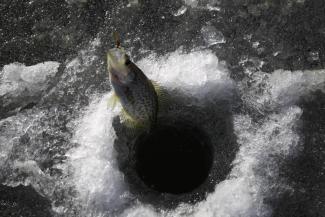Fishing in Missouri for bluegill, crappie, and other panfish does not have to end when the lakes and ponds are covered with ice. Ice fishing offers a way to extend the fishing season with no boats or expensive fishing gear. Pick a comfortable sunny day on a pond or lake with safe ice and an abundant population of bluegill or crappie, and you will be hooked on ice fishing.
If you have ever thought about trying ice fishing, but didn’t know where to start, here are the basics.
Determine If The Ice Is Safe
“Is the ice safe yet?” is the first question to ask, and the most important consideration. The ice must be at least 4 inches thick. It is impossible to determine if ice will hold you just by the appearance from the bank.
Ice strength is determined by several factors:
- Ice thickness
- Daily temperature
- Snow cover
- Depth of water under the ice
- Size of the lake
- Wind
- Current
- Wildlife activity

Always be aware of the type of ice you are drilling through. Snow on top of ice does not help ice freeze faster, rather it insulates it, shielding the surface of the lake from cold temperatures.
The best ice is hard, clear ice that you can see through.
Check the Ice
- Wait to walk onto the ice until local high temperatures have been well below freezing (32 degrees) for several days.
- With your fishing buddy (never ice fish alone), go out 3 or 4 feet from the bank and make a hole.
- If there is at least 4 inches of ice, continue another 10 or 15 feet and make another hole.
- If everything is still safe and you feel comfortable, keep going, opening holes every 50 feet to make sure ice thickness hasn’t changed.
Remember: Ice rarely forms in uniform thickness. It can be 6 inches in one spot, and 2 inches just a few feet away. An example is areas that have been kept open by ducks and geese.
Title
Augers, Axes, and Ice Picks
When cold temperatures do come, the first thing an ice angler needs is something to make a hole in the ice.
Augers, axes, and ice picks can all do the job of making a 6- to 8-inch diameter hole. Making a larger hole might seem like a good idea, but we advise against it since wider holes have the tendency to attract the boots of anglers’ feet, and wet feet in the winter will ruin a fishing trip rather quickly. Six- to 8-inch holes are plenty wide enough to fit even the biggest of Missouri’s panfish.
Although expensive power augers are available from many retailers, affordable hand-held augers are all that are necessary in Missouri since ice thickness rarely gets more than 12 inches, even in the harshest of winters in the northern part of the state.
Title
Tackle
The most common ice fishing tackle includes:
- A small, 2- to 3-foot jigging stick with an ultra-light reel
- Very light line
- Small 1/64-ounce jigs
Ice fishing poles can be homemade setups assembled from broken gear, cheaper plastic ice fishing rod and reels, or more expensive rod and reel combos. Check all your usual outdoor catalogs for the latest.
Throw your rods in that extra 5-gallon bucket you have in the garage, and you have yourself a gear transporter, a place to throw your fish, and a seat — all in one.
Title
Bait
For bait, most successful anglers use live bait, such as wax worms, which are the small white larvae of the greater wax moth, and small minnows like fatheads and shiners.
Wax worms can be hard to find some years because the ice-fishing season varies in duration from year to year. However, bait shops can order them for you, or there are many online stores. Adventurous anglers can also raise their own wax worms at home. Wax worms are hardy creatures and may last you into the spring if care is taken. Leftovers will work during the spring just as well as on the ice.
Other popular bait options
- Berkley power bait nibbles
- Gulp! scented products
- Jigging spoons
- Jigging Rapalas
- Very small plastics
Always keep in mind that using the smallest presentation possible with the lightest line you can find gives you the best shot at being successful.
Most ice-fishing opportunities in Missouri are on small lakes or farm ponds, but good fishing can also be found on city lakes, where allowed (be sure to check regulations first).
Try your favorite farm pond first. Many farm ponds are in need of some harvest to help balance the fishery. Whether the pond has a stockpiled bass population, or bluegill aren’t harvested often, fishing is a key management tool for a healthy pond fish population.
Ask your friend or relative if taking a few fish out of their pond is ok, then find the deepest part of the pond, easily located adjacent to the pond dam. During winter, fish stage in deep water over mud bottoms, gorging themselves on small aquatic organisms living in the mud.
Start by placing your bait 6 to 12 inches off the bottom, and keep the bait moving with very subtle twitches of the rod tip.
If a fish is close, they will bite. If you fail to find fish in the deep end of your pond, check a little shallower, or drill a hole next to your favorite brush pile.
Although not a requirement, modern flashers like the Vexilar and portable LCD fish finders allow anglers to easily check the depth and find concentrations of fish, eliminating the guess work that comes along with any type of fishing. Use these same guidelines to find fish in small- to medium-sized public lakes.























